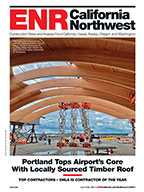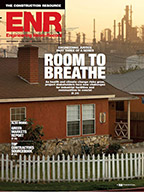One hiccup occurred when the National Fire Protection Association updated its standards for digital rather than analog controls after the first tunnel had already been built. The remaining tunnels had to meet the new standard, but all information had to feed into the same monitoring system. “We had to find a way to convert the analog feed to merge the two into a seamless display,” says van der Waart van Gulik.
During last month’s 71-hour closure to transfer traffic to the new structures, construction sequencing was planned in 15-minute increments with several stop points and backup plans in case of delays. Crews worked 40 hours nonstop at one point. None of the contingency plans were needed; the project went according to plan and the road opened eight hours early. To speed up work during the closure, crews preinstalled shafts with I-beams in the middle for future retaining walls during temporary night closures. Those posts were buried or covered so rush hour traffic could flow. Once the big road closure was underway, crews dug out those anchors and attached 2,000 preassembled rebar panel faces.
Crews used fast-curing continuously reinforced concrete pavement at four conflict points where traffic was being moved from the temporary to the permanent roadway. “It is more expensive, but cars can drive on it within hours of the pour,” says Mathews.
Now that traffic is flowing on a permanent roadway with two wider, 11-ft lanes for cars on the northbound side and three on the southbound, a 12-ft bus lane in each direction and 10-ft safety shoulders, crews will demolish the temporary bypass. Landscaped medians vary from 16 ft to 41 ft in-between the north and southbound traffic. Workers will backfill ground over the tunnels and plant 45,000 native plants that have been nurtured during the project to connect Presidio Park to Crissy Marsh. Local landscape architect Michael Painter’s design called for restoring wetlands by removing culverts and restoring and widening Dragonfly Creek.
When complete, the roadways will include screens to keep auto lights from impacting the wetlands environment. Phase 1 received a Greenroads bronze designation and Phase 2 is pursuing silver certification. The overall effort is “the largest Greenroads-certified project in the country,” says van der Waart van Gulik.







Post a comment to this article
Report Abusive Comment